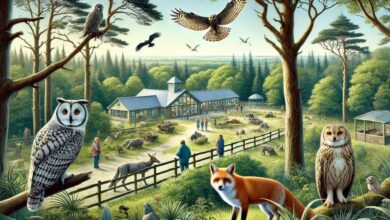Understanding Ecosystem Theme Words: Key Concepts and Their Importance

In the study of ecosystems, there are numerous terms and concepts that are integral to understanding how these natural systems function. “Ecosystem theme words” provide a foundation for grasping the complexities of ecological processes, the interdependencies between living organisms, and the balance required for ecosystems to thrive. This article will dive deep into essential ecosystem theme words and their significance, breaking them down into digestible sections to illuminate their meaning and application in environmental science.
What Are Ecosystem Theme Words?
Ecosystem theme words refer to specific terms that describe the components, functions, and interactions within ecosystems. These words help explain how ecosystems operate and sustain life, emphasizing key concepts such as biodiversity, energy flow, nutrient cycling, and more. By understanding these words, individuals can better appreciate the delicate balance within natural environments and the importance of preserving ecosystems for future generations.
1. Biodiversity
One of the most critical ecosystem theme words is biodiversity, which refers to the variety of life within an ecosystem. This encompasses the diversity of species, genetics, and ecosystems themselves. Biodiversity plays a fundamental role in maintaining the health of an ecosystem, as each species contributes to the overall functionality of the system.
In an ecosystem, diverse species interact through a web of food chains, with each organism fulfilling a specific role. From plants that provide oxygen through photosynthesis to predators that control herbivore populations, every species is crucial. The more biodiverse an ecosystem is, the more resilient it is to changes, such as climate shifts or human interference. This makes biodiversity a key factor in ecosystem sustainability.
2. Energy Flow
Another essential ecosystem theme word is energy flow. This concept explains how energy moves through an ecosystem, beginning with the sun and passing through various organisms. Energy flow typically starts with plants (producers) that convert solar energy into chemical energy through photosynthesis. This energy is then transferred to herbivores (primary consumers) that eat the plants, and from there, it moves up the food chain to predators (secondary and tertiary consumers).
Energy flow is vital because it sustains all life within the ecosystem. Without a continuous supply of energy, ecosystems would collapse, as organisms would not have the means to carry out essential life processes. Understanding how energy flows through ecosystems highlights the importance of each link in the food chain and the need to preserve energy sources like sunlight and plant life.
3. Nutrient Cycling
Nutrient cycling refers to the movement of nutrients such as carbon, nitrogen, and phosphorus within an ecosystem. These nutrients are essential for plant growth and animal survival, and they move through ecosystems in continuous cycles. For example, the carbon cycle involves the absorption of carbon dioxide by plants during photosynthesis, which is then passed along to animals and eventually returned to the atmosphere through respiration or decomposition.
Nutrient cycling is crucial for maintaining soil fertility, supporting plant growth, and ensuring that ecosystems can continue to sustain life. Disruptions to these cycles—such as through pollution or deforestation—can lead to nutrient imbalances, harming plant and animal life. Therefore, nutrient cycling is a vital process that keeps ecosystems functioning smoothly.
4. Habitat
A habitat is the natural environment in which a particular species lives. Each ecosystem contains multiple habitats, such as forests, wetlands, and oceans, that support different types of organisms. Habitats provide the resources organisms need to survive, including food, water, and shelter.
The loss or degradation of habitats due to human activities such as urbanization and deforestation is one of the greatest threats to biodiversity. When habitats are destroyed, the species that rely on them may face extinction. Protecting natural habitats is essential for maintaining healthy ecosystems and ensuring the survival of diverse species.
5. Carrying Capacity
Carrying capacity is a term used to describe the maximum population size of a species that an ecosystem can support indefinitely. This is determined by the availability of resources such as food, water, and shelter. When a population exceeds its carrying capacity, it may experience a decline due to resource depletion, leading to starvation, disease, or migration.
Understanding carrying capacity is important for managing ecosystems sustainably. For example, wildlife conservation efforts often focus on maintaining populations within their ecosystem’s carrying capacity to prevent overpopulation and the degradation of resources.
6. Interdependence
Interdependence in ecosystems refers to the reliance of organisms on one another for survival. No organism lives in isolation; plants depend on pollinators, predators control prey populations, and decomposers break down organic matter to return nutrients to the soil. This interdependence creates a complex web of interactions that keeps ecosystems balanced and functioning.
For example, in a forest ecosystem, trees provide habitat and food for animals, while animals help disperse seeds and pollinate plants. Decomposers, such as fungi and bacteria, break down dead organic matter, returning nutrients to the soil for plants to use. This interdependence ensures that ecosystems remain stable and can recover from disturbances.
7. Ecosystem Services
Ecosystem services are the benefits that humans derive from ecosystems, such as clean water, air, and food. These services also include processes like pollination, water purification, and climate regulation. Ecosystem services are critical for human survival and well-being, yet they are often taken for granted.
When ecosystems are damaged or destroyed, the services they provide can be diminished or lost. For example, deforestation can lead to the loss of water filtration services provided by forests, resulting in polluted water sources. Recognizing the value of ecosystem services is key to promoting conservation and sustainable resource management.
8. Food Webs
Food webs illustrate the complex feeding relationships within an ecosystem. Unlike a simple food chain, which follows a linear path, a food web shows how various organisms interact and depend on each other for food. It includes multiple food chains and highlights the interconnections between predators, prey, and producers.
Food webs are essential for understanding ecosystem dynamics, as they demonstrate how energy flows and nutrients cycle within the system. The removal of one species from the web can have cascading effects on the entire ecosystem, disrupting the balance and leading to unintended consequences.
9. Keystone Species
A keystone species is a species that has a disproportionately large impact on its ecosystem relative to its population size. These species play a critical role in maintaining the structure and function of the ecosystem. For example, wolves in Yellowstone National Park are considered a keystone species because their presence helps regulate prey populations and maintain the balance of the ecosystem.
The loss of a keystone species can cause significant changes in the ecosystem, potentially leading to its collapse. Protecting keystone species is crucial for preserving biodiversity and ecosystem health.
Conclusion
Ecosystem theme words, such as biodiversity, energy flow, nutrient cycling, habitat, and interdependence, provide valuable insights into the complex workings of ecosystems. These terms help us understand the delicate balance that sustains life on Earth and the importance of preserving natural environments. By familiarizing ourselves with these concepts, we can better appreciate the interconnectedness of life and the need for sustainable environmental practices to protect ecosystems for future generations.
Understanding and applying these ecosystem theme words in discussions about environmental conservation is essential to fostering a deeper awareness of how natural systems operate and the role we play in maintaining them.



